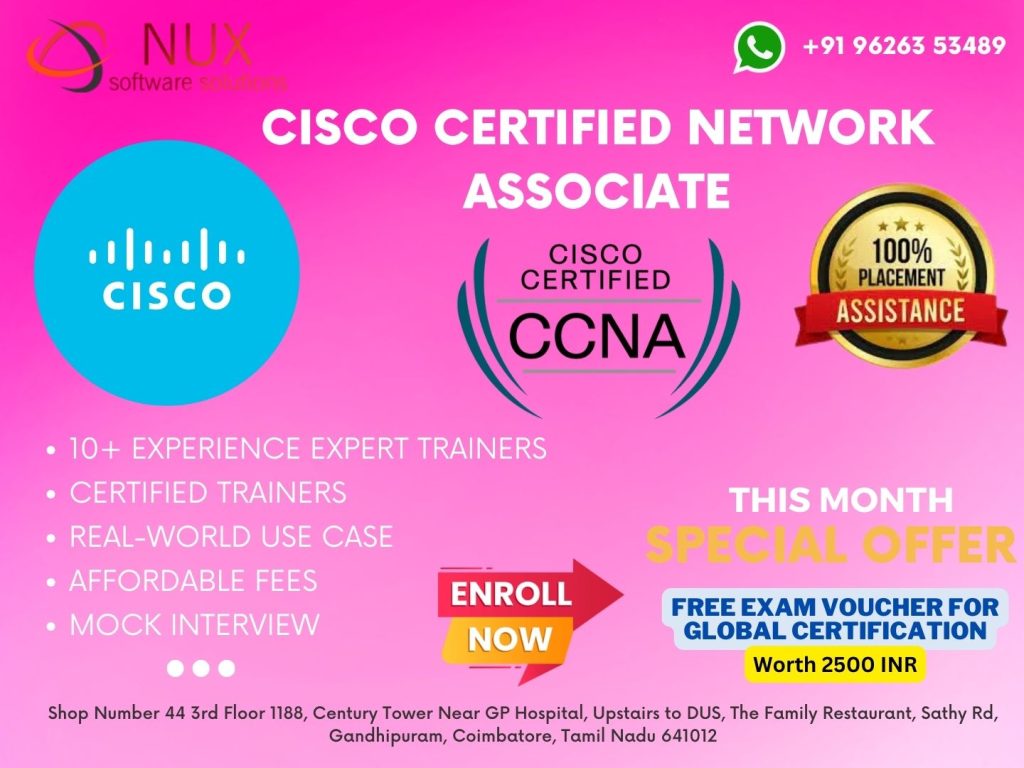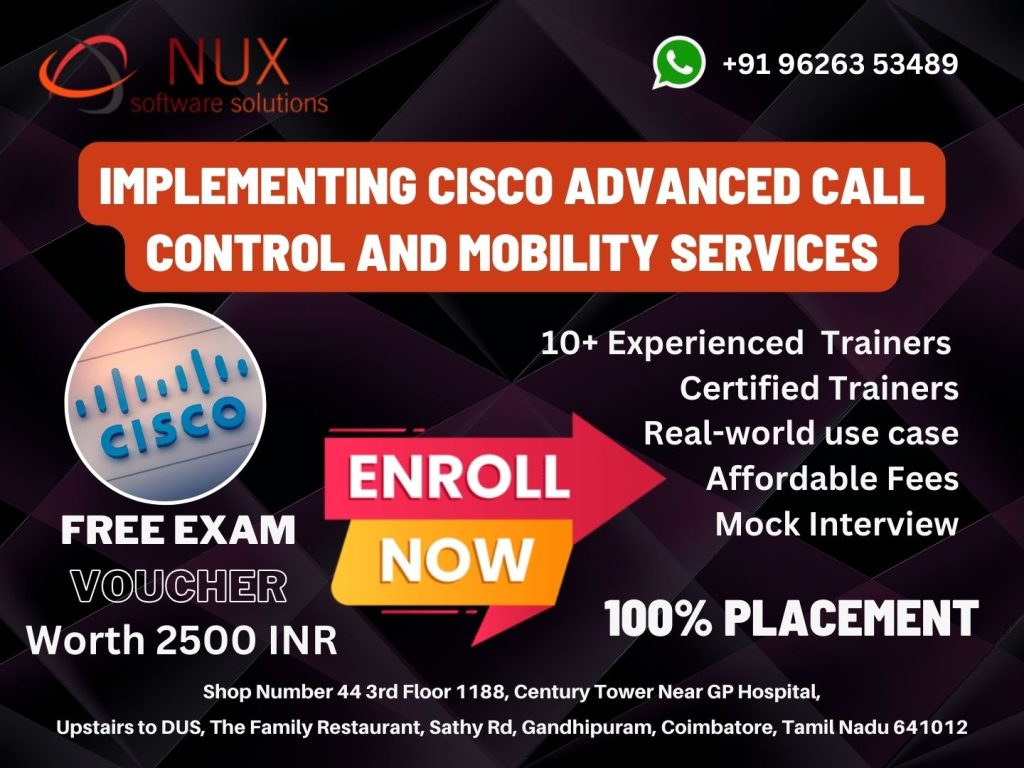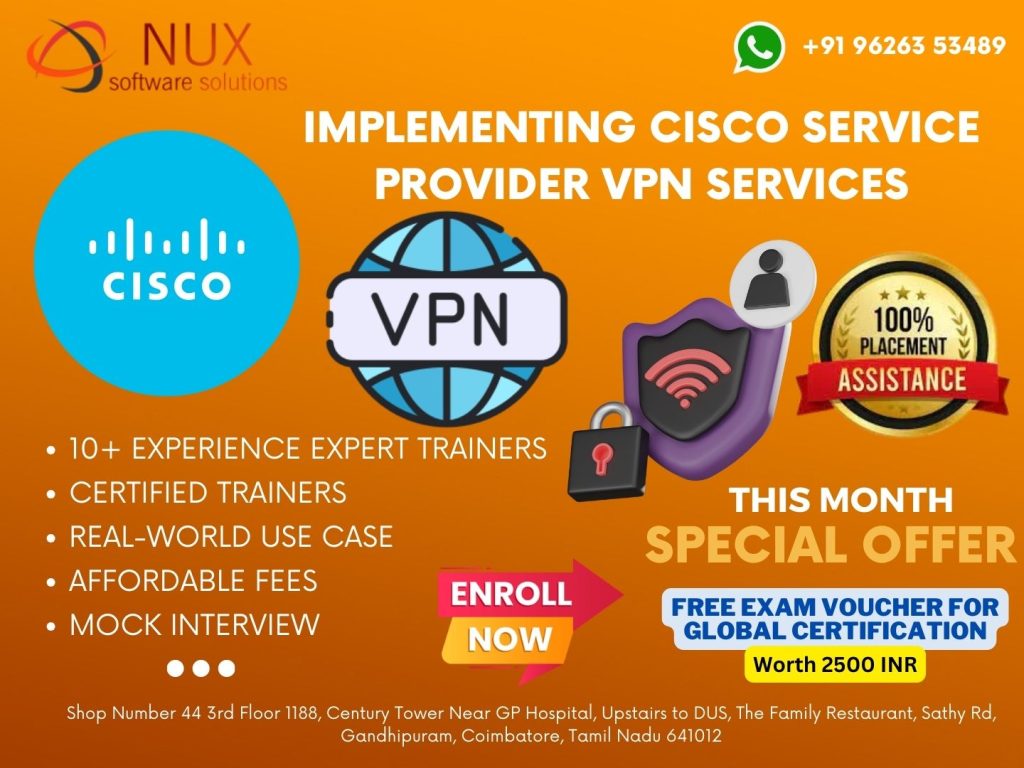Cisco Certified Entry Networking Technician (CCENT)

Cisco Certified Entry Networking Technician (CCENT) Training in Coimbatore
Course Overview
The Cisco Certified Entry Networking Technician (CCENT) certification is a foundational networking certification from Cisco, designed for beginners who are starting their journey in the field of IT networking. It validates the essential skills required to install, operate, and troubleshoot a small enterprise branch network, including basic network security and wireless concepts.
At Linux Training Center in Coimbatore, the CCENT training course is tailored to help students, fresh graduates, and aspiring network professionals gain a strong understanding of networking fundamentals and Cisco technologies. This course offers hands-on lab practice, real-world scenarios, and instructor-led sessions to ensure practical knowledge and confidence in entry-level networking roles.
Why Choose the CCENT Certification?
Even though Cisco has retired the CCENT certification as a standalone credential, the content remains highly relevant for those preparing for Cisco Certified Network Associate (CCNA) and those seeking an entry point into the world of networking.
The CCENT curriculum is designed to build a solid foundation in networking concepts, making it an ideal starting point for a career in IT. It covers the core areas such as IP addressing, subnetting, basic routing and switching, network security fundamentals, and troubleshooting skills.
This training will provide all the knowledge and practical exposure needed to step confidently into more advanced certifications and IT roles.
Who Should Enroll?
This course is ideal for:
-
Students and graduates pursuing careers in IT
-
Beginners interested in networking and system administration
-
Desktop support engineers and junior network technicians
-
Candidates preparing for CCNA and other higher-level Cisco certifications
-
Anyone switching from non-technical to technical roles
No prior networking experience is required to join this course.
What You Will Learn
-
Introduction to networking and the OSI model
-
TCP/IP protocols and IP addressing
-
Subnetting and VLSM (Variable Length Subnet Masking)
-
Basic router and switch configuration
-
WAN technologies and network media
-
DHCP, NAT, and ACL configuration basics
-
Troubleshooting connectivity issues using Cisco IOS
-
Basic network security concepts and best practices
-
Wireless LAN concepts and configuration essentials
The course includes interactive lab exercises using real or simulated Cisco equipment for hands-on practice.
Course Highlights
-
Designed for absolute beginners in networking
-
Delivered by Cisco-certified trainers with industry experience
-
Real-time lab access and simulation tools
-
Includes preparation for transitioning into CCNA training
-
Focus on both theoretical concepts and practical implementation
-
Weekday, weekend, and online training options available in Coimbatore
Career Opportunities
Upon completing the CCENT-aligned training, learners can explore various entry-level roles such as:
-
Network Support Technician
-
Help Desk Technician
-
IT Support Associate
-
Junior Network Administrator
-
Technical Support Engineer
With further training and experience, these roles can evolve into network engineer, systems administrator, or IT consultant positions.
Why Linux Training Center, Coimbatore?
At Linux Training Center, we understand the importance of building a solid base. Our CCENT training is structured to simplify complex networking topics and build your confidence with real-time problem-solving. Whether you’re a student, a jobseeker, or switching careers, our program empowers you with the skills and support to start strong in the IT industry.
CCENT Syllabus
Introduction
Chapter 1
Compare and contrast OSI and TCP/IP models
Chapter 2
Compare and contrast TCP and UDP protocols
Chapter 3
Describe the impact of infrastructure components in an enterprise network
a) Firewalls, b) Access points, c) Wireless controllers
Chapter 4
Compare and contrast collapsed core and three-tier architectures
Chapter 5
Compare and contrast network topologies
a) Star, b) Mesh, c) Hybrid
Chapter 6
Select the appropriate cabling type based on implementation requirements
Chapter 7
Apply troubleshooting methodologies to resolve problems
a) Perform fault isolation and document, b) Resolve or escalate, c) Verify and monitor resolution
Chapter 8
Configure, verify, and troubleshoot IPv4 addressing and subnetting
Chapter 9
Compare and contrast IPv4 address types
a) Unicast, b) Broadcast, c) Multicast
CHAPTR 10
Describe the need for private IPv4 addressing
Chapter 11
Identify the appropriate IPv6 addressing scheme to satisfy addressing requirements in a LAN/WAN environment
Chapter 12
Configure, verify, and troubleshoot IPv6 addressing
Chapter 13
Configure and verify IPv6 Stateless Address Auto Configuration
Chapter 14
Compare and contrast IPv6 address types
a) Global unicast, b) Unique local, c) Link local, d) Multicast, e) Modified EUI 64, f) Autoconfiguration, g) Anycast
Chapter 15
Describe and verify switching concepts
a) MAC learning and aging, b) Frame switching, c) Frame flooding, d) MAC address table
Chapter 16
Interpret Ethernet frame format
Chapter 17
Troubleshoot interface and cable issues (collisions, errors, duplex, speed)
Chapter 18
Configure, verify, and troubleshoot VLANs (normal range) spanning multiple switches
a) Access ports (data and voice), b) Default VLAN
Chapter 18
Configure, verify, and troubleshoot interswitch connectivity
a) Trunk ports, b) 802.1Q, c) Native VLAN
Chapter 19
Configure and verify Layer 2 protocols
a) Cisco Discovery Protocol, b) LLDP
Chapter 20
Configure, verify, and troubleshoot port security
a) Static, b) Dynamic, c) Sticky, d) Max MAC addresses, e) Violation actions, f) Err-disable recovery
Chapter 21
Describe the routing concepts
a) Packet handling along the path through a network, b) Forwarding decision based on route lookup, c) Frame rewrite
Chapter 22
Interpret the components of routing table
a) Prefix, b) Network mask, c) Next hop, d) Routing protocol code, e) Administrative distance, f) Metric, g) Gateway of last resort
CHAPETER 23
Describe how a routing table is populated by different routing information sources
a) Admin distance
Chapter 24
Configure, verify, and troubleshoot inter-VLAN routing
a) Router on a stick
Chapter 25
Compare and contrast static routing and dynamic routing
Chapter 26
Configure, verify, and troubleshoot IPv4 and IPv6 static routing
a) Default route, b) Network route, c) Host route, d) Floating static
Chapter 27
Configure, verify, and troubleshoot RIPv2 for IPv4 (excluding authentication, filtering, manual summarization, redistribution)
Chapter 28
Describe DNS lookup operation
Chapter 29
Troubleshoot client connectivity issues involving DNS
Chapter 30
Configure and verify DHCP on a router (excluding static reservations)
a) Server, b) Relay, c) Client, d) TFTP, DNS, and gateway options
Chapter 31
Troubleshoot client- and router-based DHCP connectivity issues
Chapter 32
Configure and verify NTP operating in client/server mode
Chapter 33
Configure, verify, and troubleshoot IPv4 standard numbered and named access list for routed interfaces
Chapter 34
Configure, verify, and troubleshoot inside source NAT
a) Static, b) Pool, c) PAT
Chapter 35
Configure and verify device-monitoring using syslog
Chapter 36
Configure and verify device management
a) Backup and restore device configuration, b) Using Cisco Discovery Protocol and LLDP for device discovery, c) Licensing, d) Logging, e) Timezone, f) Loopback
Chapter 36
Configure and verify initial device configuration
Chapter 37
Configure, verify, and troubleshoot basic device hardening
a) Local authentication, b) Secure password,
c) Access to device
[i] Source address, [ii] Telnet/SSH
d) Login banner
Chapter 39
Perform device maintenance
a) Cisco IOS upgrades and recovery (SCP, FTP, TFTP, and MD5 verify), b) Password recovery and configuration register, c) File system management
Chapter 39
Use Cisco IOS tools to troubleshoot and resolve problems
a) Ping and traceroute with extended option, b) Terminal monitor, c) Log events



